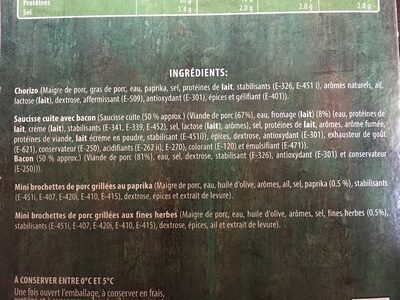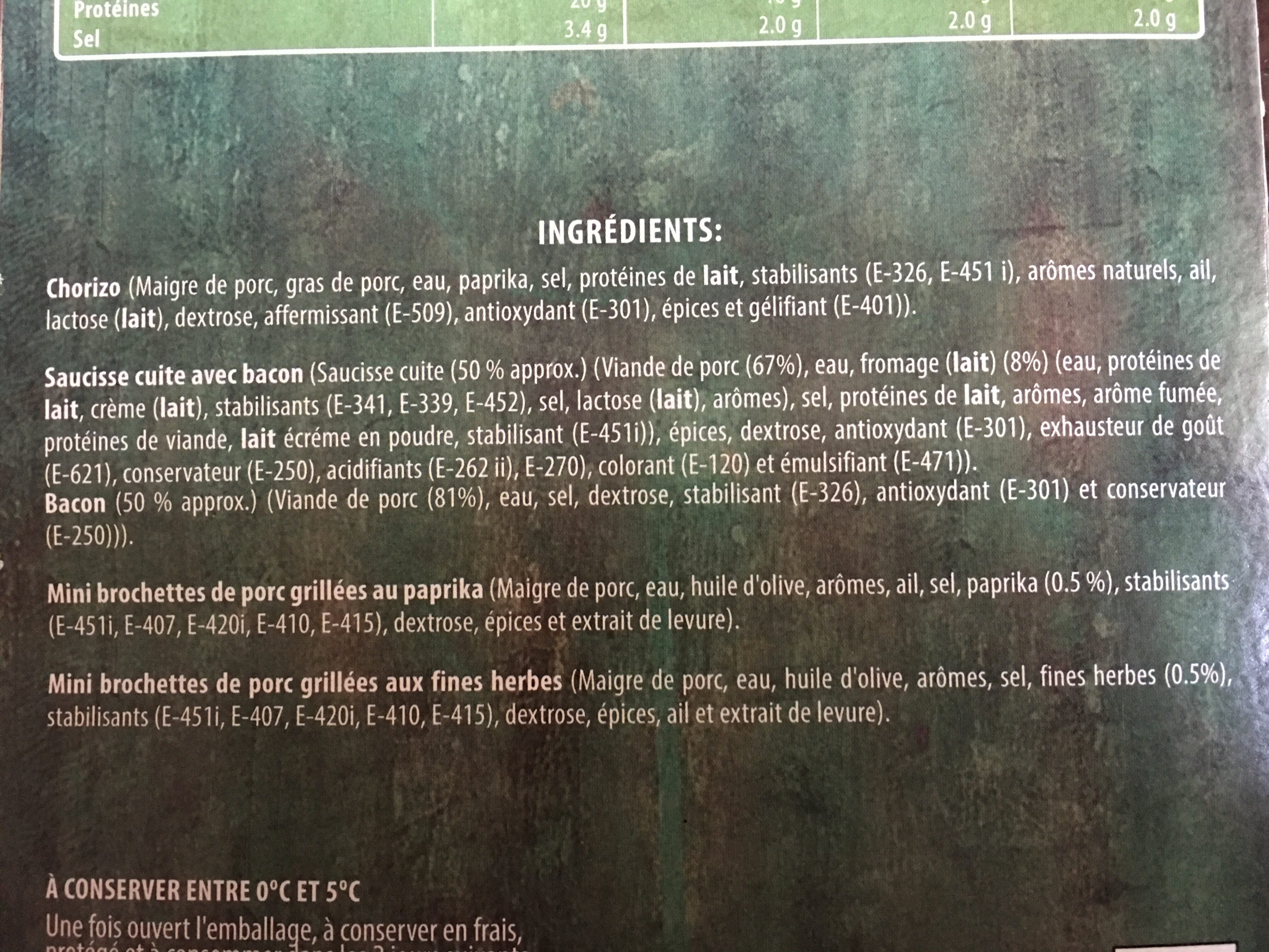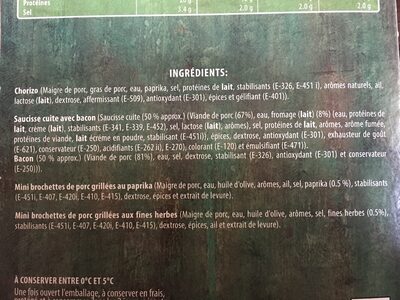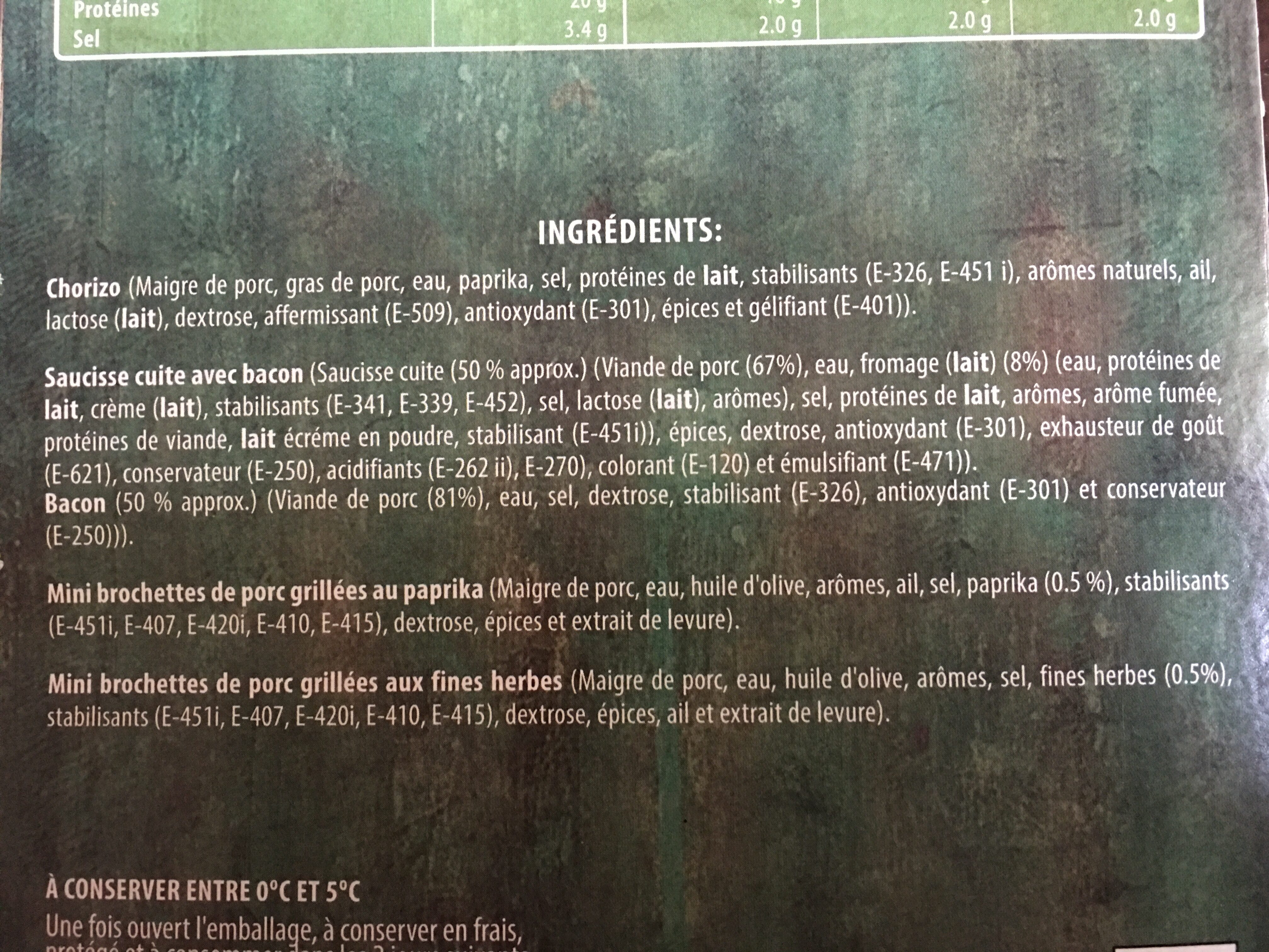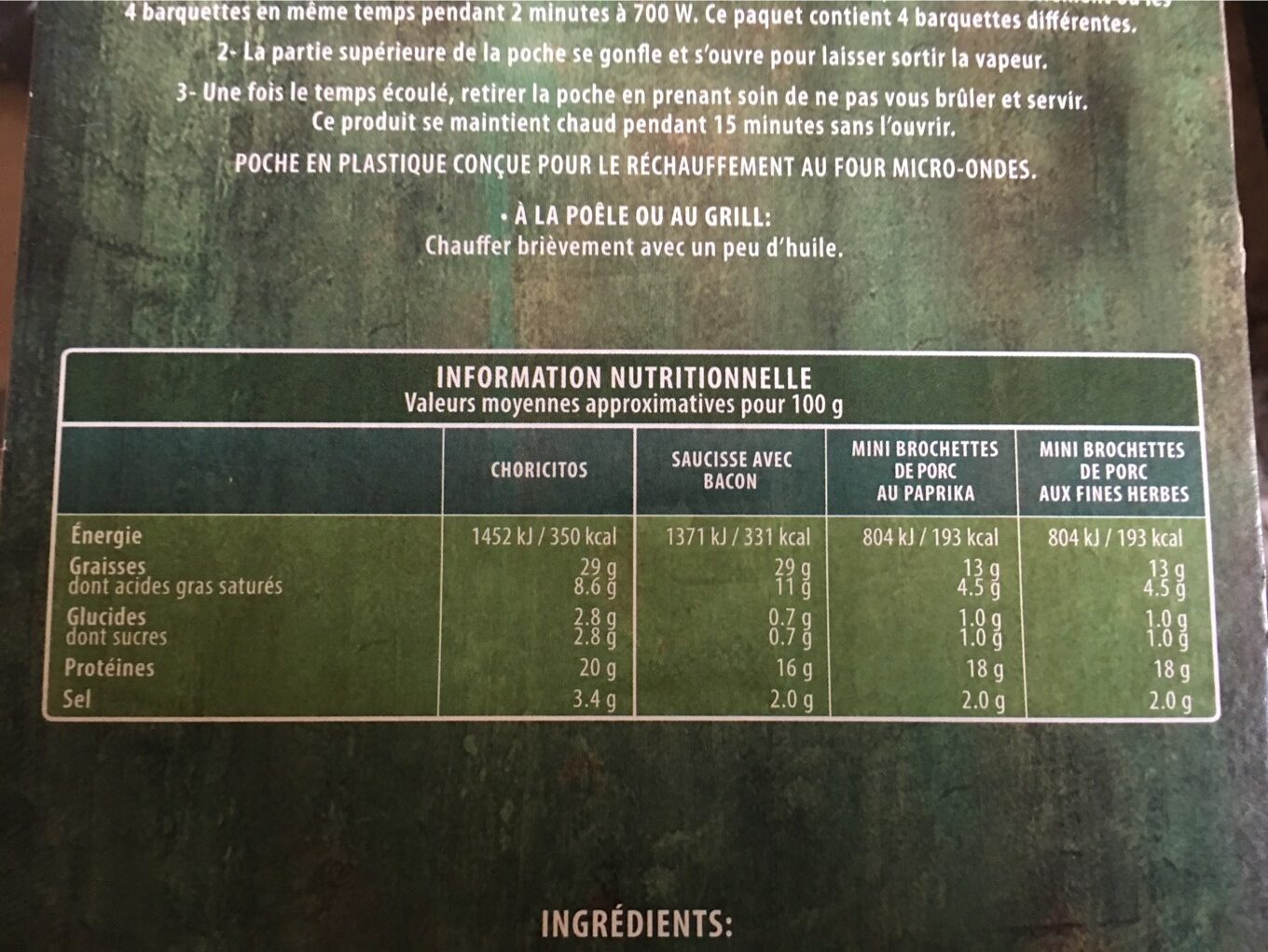Help us make food transparency the norm!
As a non-profit organization, we depend on your donations to continue informing consumers around the world about what they eat.
The food revolution starts with you!
Tapas Al Minuto - Espuna
Tapas Al Minuto - Espuna
This product page is not complete. You can help to complete it by editing it and adding more data from the photos we have, or by taking more photos using the app for Android or iPhone/iPad. Thank you!
×
Barcode: 8410060509207 (EAN / EAN-13)
Brands: Espuna
Categories: Snacks, Salty snacks, Appetizers, Tapas
Stores: Magasins U
Countries where sold: France
Matching with your preferences
Health
Ingredients
-
109 ingredients
French: '. Chorizo (Maigre de porc, gras de porc, eau, paprika, sel, protéines de lait, stabilisants (E-326, E-451 i), arômes naturels, ail, lactose (lait), dextrose, affermissant (E-509), antioxydant (E-301), épices et gélifiant (E-401)). Saucisse cuite avec bacon (Saucisse cuite (50 % app(ox.) (Viande de porc (67%), eau, fromage (lait) (8%) (eau, protéines de lait, crème (lait), stabilisants (E-341, E-339, E-452), sel, lactose (lait), arômes), sel, protéines de lait, arômes, arôme fumee, protéines de viande, lait écréme en poudre, stabilisant (E-451i)), épices, dextrose, antioxydant (E-301), exhausteur de goût (E-621), conservateur (E-250), acidifiants (E-262 ii)i E-270), colorant (E-120) et émulsifiant (E-471)). Bacon (50 % approx.) (Viande de porc (81%), eau, sel, dextrose, stabilisant (E-326), antioxydant (E-301) et conservateur (E-250))). Mini brochettes de porc grillées au paprika (Maigre de porc, eau, huile d'olive, arômes, ail, sel, paprika (0.5 %), stabilisants (E-451 i, E-407, E-420i, E-410, E-415), dextrose, épices et extrait de levure). Mini brochettes de porc grillées aux fines herbes (Maigre de porc, eau, huile d'olive, arômes, sel, fines herbes (0.5%), stabilisants (E-451 i, E-407, E-420i, E-410, E-415), dextrose, épices, ail et extrait de levure). À CONSERVER ENTRE OOC ET Une foi} ouyert l'emballaqe, à conserver en fraisAllergens: Milk
Food processing
-
Ultra processed foods
Elements that indicate the product is in the 4 - Ultra processed food and drink products group:
- Additive: E120 - Cochineal
- Additive: E326 - Potassium lactate
- Additive: E401 - Sodium alginate
- Additive: E407 - Carrageenan
- Additive: E410 - Locust bean gum
- Additive: E415 - Xanthan gum
- Additive: E420 - Sorbitol
- Additive: E451 - Triphosphates
- Additive: E452 - Polyphosphates
- Additive: E471 - Mono- and diglycerides of fatty acids
- Additive: E621 - Monosodium glutamate
- Ingredient: Colour
- Ingredient: Dextrose
- Ingredient: Emulsifier
- Ingredient: Firming agent
- Ingredient: Flavour enhancer
- Ingredient: Flavouring
- Ingredient: Gelling agent
- Ingredient: Glucose
- Ingredient: Lactose
- Ingredient: Milk proteins
Food products are classified into 4 groups according to their degree of processing:
- Unprocessed or minimally processed foods
- Processed culinary ingredients
- Processed foods
- Ultra processed foods
The determination of the group is based on the category of the product and on the ingredients it contains.
Additives
-
E120 - Cochineal
Carminic acid: Carminic acid -C22H20O13- is a red glucosidal hydroxyanthrapurin that occurs naturally in some scale insects, such as the cochineal, Armenian cochineal, and Polish cochineal. The insects produce the acid as a deterrent to predators. An aluminum salt of carminic acid is the coloring agent in carmine. Synonyms are C.I. 75470 and C.I. Natural Red 4. The chemical structure of carminic acid consists of a core anthraquinone structure linked to a glucose sugar unit. Carminic acid was first synthesized in the laboratory by organic chemists in 1991.Source: Wikipedia
-
E250 - Sodium nitrite
Sodium nitrite: Sodium nitrite is the inorganic compound with the chemical formula NaNO2. It is a white to slightly yellowish crystalline powder that is very soluble in water and is hygroscopic. It is a useful precursor to a variety of organic compounds, such as pharmaceuticals, dyes, and pesticides, but it is probably best known as a food additive to prevent botulism. It is on the World Health Organization's List of Essential Medicines, the most important medications needed in a basic health system.Nitrate or nitrite -ingested- under conditions that result in endogenous nitrosation has been classified as "probably carcinogenic to humans" by International Agency for Research on Cancer -IARC-.Source: Wikipedia
-
E262 - Sodium acetates
Sodium acetate: Sodium acetate, CH3COONa, also abbreviated NaOAc, is the sodium salt of acetic acid. This colorless deliquescent salt has a wide range of uses.Source: Wikipedia
-
E262ii - Sodium diacetate
Sodium acetate: Sodium acetate, CH3COONa, also abbreviated NaOAc, is the sodium salt of acetic acid. This colorless deliquescent salt has a wide range of uses.Source: Wikipedia
-
E301 - Sodium ascorbate
Sodium ascorbate: Sodium ascorbate is one of a number of mineral salts of ascorbic acid -vitamin C-. The molecular formula of this chemical compound is C6H7NaO6. As the sodium salt of ascorbic acid, it is known as a mineral ascorbate. It has not been demonstrated to be more bioavailable than any other form of vitamin C supplement.Sodium ascorbate normally provides 131 mg of sodium per 1‚000 mg of ascorbic acid -1‚000 mg of sodium ascorbate contains 889 mg of ascorbic acid and 111 mg of sodium-. As a food additive, it has the E number E301 and is used as an antioxidant and an acidity regulator. It is approved for use as a food additive in the EU, USA, and Australia and New Zealand.In in vitro studies, sodium ascorbate has been found to produce cytotoxic effects in various malignant cell lines, which include melanoma cells that are particularly susceptible.Source: Wikipedia
-
E326 - Potassium lactate
Potassium lactate: Potassium lactate is a compound with formula KC3H5O3, or H3C-CHOH-COOK. It is the potassium salt of lactic acid. It is produced by neutralizing lactic acid which is fermented from a sugar source. It has E number "E326". Potassium lactate is a liquid product that is usually 60% solids but is available at up to 78% solids.Potassium lactate is commonly used in meat and poultry products to extend shelf life and increase food safety as it has a broad antimicrobial action and is effective at inhibiting most spoilage and pathogenic bacteria. Potassium lactate is also used as an extinguishing medium in the First Alert Tundra fire extinguishers.Source: Wikipedia
-
E339 - Sodium phosphates
Sodium phosphates: Sodium phosphate is a generic term for a variety of salts of sodium -Na+- and phosphate -PO43−-. Phosphate also forms families or condensed anions including di-, tri-, tetra-, and polyphosphates. Most of these salts are known in both anhydrous -water-free- and hydrated forms. The hydrates are more common than the anhydrous forms.Source: Wikipedia
-
E341 - Calcium phosphates
Calcium phosphate: Calcium phosphate is a family of materials and minerals containing calcium ions -Ca2+- together with inorganic phosphate anions. Some so-called calcium phosphates contain oxide and hydroxide as well. They are white solids of nutritious value.Source: Wikipedia
-
E407 - Carrageenan
Carrageenan (E407), derived from red seaweed, is widely employed in the food industry as a gelling, thickening, and stabilizing agent, notably in dairy and meat products.
It can exist in various forms, each imparting distinct textural properties to food.
However, its degraded form, often referred to as poligeenan, has raised health concerns due to its potential inflammatory effects and its classification as a possible human carcinogen (Group 2B) by the International Agency for Research on Cancer (IARC).
Nevertheless, food-grade carrageenan has been deemed safe by various regulatory bodies when consumed in amounts typically found in food.
-
E410 - Locust bean gum
Locust bean gum: Locust bean gum -LBG, also known as carob gum, carob bean gum, carobin, E410- is a thickening agent and a gelling agent used in food technology.Source: Wikipedia
-
E415 - Xanthan gum
Xanthan gum (E415) is a natural polysaccharide derived from fermented sugars, often used in the food industry as a thickening and stabilizing agent.
This versatile food additive enhances texture and prevents ingredient separation in a wide range of products, including salad dressings, sauces, and gluten-free baked goods.
It is considered safe for consumption even at high intake amounts.
-
E420 - Sorbitol
Sorbitol: Sorbitol --, less commonly known as glucitol --, is a sugar alcohol with a sweet taste which the human body metabolizes slowly. It can be obtained by reduction of glucose, which changes the aldehyde group to a hydroxyl group. Most sorbitol is made from corn syrup, but it is also found in nature, for example in apples, pears, peaches, and prunes. It is converted to fructose by sorbitol-6-phosphate 2-dehydrogenase. Sorbitol is an isomer of mannitol, another sugar alcohol; the two differ only in the orientation of the hydroxyl group on carbon 2. While similar, the two sugar alcohols have very different sources in nature, melting points, and uses.Source: Wikipedia
-
E420i - D-sorbitol
Sorbitol: Sorbitol --, less commonly known as glucitol --, is a sugar alcohol with a sweet taste which the human body metabolizes slowly. It can be obtained by reduction of glucose, which changes the aldehyde group to a hydroxyl group. Most sorbitol is made from corn syrup, but it is also found in nature, for example in apples, pears, peaches, and prunes. It is converted to fructose by sorbitol-6-phosphate 2-dehydrogenase. Sorbitol is an isomer of mannitol, another sugar alcohol; the two differ only in the orientation of the hydroxyl group on carbon 2. While similar, the two sugar alcohols have very different sources in nature, melting points, and uses.Source: Wikipedia
-
E451 - Triphosphates
Sodium triphosphate: Sodium triphosphate -STP-, also sodium tripolyphosphate -STPP-, or tripolyphosphate -TPP-,- is an inorganic compound with formula Na5P3O10. It is the sodium salt of the polyphosphate penta-anion, which is the conjugate base of triphosphoric acid. It is produced on a large scale as a component of many domestic and industrial products, especially detergents. Environmental problems associated with eutrophication are attributed to its widespread use.Source: Wikipedia
-
E451i - Pentasodium triphosphate
Sodium triphosphate: Sodium triphosphate -STP-, also sodium tripolyphosphate -STPP-, or tripolyphosphate -TPP-,- is an inorganic compound with formula Na5P3O10. It is the sodium salt of the polyphosphate penta-anion, which is the conjugate base of triphosphoric acid. It is produced on a large scale as a component of many domestic and industrial products, especially detergents. Environmental problems associated with eutrophication are attributed to its widespread use.Source: Wikipedia
-
E471 - Mono- and diglycerides of fatty acids
Mono- and diglycerides of fatty acids (E471), are food additives commonly used as emulsifiers in various processed foods.
These compounds consist of glycerol molecules linked to one or two fatty acid chains, which help stabilize and blend water and oil-based ingredients. E471 enhances the texture and shelf life of products like margarine, baked goods, and ice cream, ensuring a smooth and consistent texture.
It is generally considered safe for consumption within established regulatory limits.
-
E509 - Calcium chloride
Calcium chloride: Calcium chloride is an inorganic compound, a salt with the chemical formula CaCl2. It is a colorless crystalline solid at room temperature, highly soluble in water. Calcium chloride is commonly encountered as a hydrated solid with generic formula CaCl2-H2O-x, where x = 0, 1, 2, 4, and 6. These compounds are mainly used for de-icing and dust control. Because the anhydrous salt is hygroscopic, it is used as a desiccant.Source: Wikipedia
-
E621 - Monosodium glutamate
Monosodium glutamate: Monosodium glutamate -MSG, also known as sodium glutamate- is the sodium salt of glutamic acid, one of the most abundant naturally occurring non-essential amino acids. Glutamic acid is found naturally in tomatoes, grapes, cheese, mushrooms and other foods.MSG is used in the food industry as a flavor enhancer with an umami taste that intensifies the meaty, savory flavor of food, as naturally occurring glutamate does in foods such as stews and meat soups. It was first prepared in 1908 by Japanese biochemist Kikunae Ikeda, who was trying to isolate and duplicate the savory taste of kombu, an edible seaweed used as a base for many Japanese soups. MSG as a flavor enhancer balances, blends, and rounds the perception of other tastes.The U.S. Food and Drug Administration has given MSG its generally recognized as safe -GRAS- designation. A popular belief is that large doses of MSG can cause headaches and other feelings of discomfort, known as "Chinese restaurant syndrome," but double-blind tests fail to find evidence of such a reaction. The European Union classifies it as a food additive permitted in certain foods and subject to quantitative limits. MSG has the HS code 29224220 and the E number E621.Source: Wikipedia
Ingredients analysis
-
May contain palm oil
Ingredients that may contain palm oil: Pork fat, E471
-
Non-vegan
Non-vegan ingredients: Chorizo, Lean pork, Pork fat, Milk proteins, Lactose, Bone, Pork meat, Cheese, Milk proteins, Cream, Lactose, Milk proteins, Skimmed milk powder, E120, Bacon, Pork meat, Lean pork, Lean porkSome ingredients could not be recognized.
We need your help!
You can help us recognize more ingredients and better analyze the list of ingredients for this product and others:
- Edit this product page to correct spelling mistakes in the ingredients list, and/or to remove ingredients in other languages and sentences that are not related to the ingredients.
- Add new entries, synonyms or translations to our multilingual lists of ingredients, ingredient processing methods, and labels.
If you would like to help, join the #ingredients channel on our Slack discussion space and/or learn about ingredients analysis on our wiki. Thank you!
-
Non-vegetarian
Non-vegetarian ingredients: Chorizo, Lean pork, Pork fat, Bone, Pork meat, E120, Bacon, Pork meat, Lean pork, Lean porkSome ingredients could not be recognized.
We need your help!
You can help us recognize more ingredients and better analyze the list of ingredients for this product and others:
- Edit this product page to correct spelling mistakes in the ingredients list, and/or to remove ingredients in other languages and sentences that are not related to the ingredients.
- Add new entries, synonyms or translations to our multilingual lists of ingredients, ingredient processing methods, and labels.
If you would like to help, join the #ingredients channel on our Slack discussion space and/or learn about ingredients analysis on our wiki. Thank you!
-
Details of the analysis of the ingredients
We need your help!
Some ingredients could not be recognized.
We need your help!
You can help us recognize more ingredients and better analyze the list of ingredients for this product and others:
- Edit this product page to correct spelling mistakes in the ingredients list, and/or to remove ingredients in other languages and sentences that are not related to the ingredients.
- Add new entries, synonyms or translations to our multilingual lists of ingredients, ingredient processing methods, and labels.
If you would like to help, join the #ingredients channel on our Slack discussion space and/or learn about ingredients analysis on our wiki. Thank you!
fr: Chorizo (Maigre de porc, gras de porc, eau, paprika, sel, protéines de lait, stabilisants (e326, e451i), arômes naturels, ail, lactose, dextrose, affermissant (e509), antioxydant (e301), épices, gélifiant (e401)), Saucisse cuite avec bacon, Saucisse cuite, app 50% (ox), Viande de porc 67%, eau, fromage (eau, protéines de lait, crème, stabilisants (e341, e339, e452), sel, lactose, arômes), sel, protéines de lait, arômes, arôme fumee, protéines de viande, lait écréme en poudre, stabilisant (e451i), épices, dextrose, antioxydant (e301), exhausteur de goût (e621), conservateur (e250), acidifiants (e262ii), i e270, colorant (e120), émulsifiant (e471), Bacon (approx 50%, Viande de porc 81%, eau, sel, dextrose, stabilisant (e326), antioxydant (e301), conservateur (e250)), Mini brochettes de porc grillées au paprika (Maigre de porc, eau, huile d'olive, arômes, ail, sel, paprika 0.5%, stabilisants (e451i, e407, e420i, e410, e415), dextrose, épices, extrait de levure), Mini brochettes de porc grillées aux fines herbes (Maigre de porc, eau, huile d'olive, arômes, sel, fines herbes 0.5%, stabilisants (e451i, e407, e420i, e410, e415), dextrose, épices, ail, extrait de levure), À CONSERVER ENTRE OOC et Une foi} ouyert l'emballaqe, à conserver en frais- Chorizo -> en:chorizo - vegan: no - vegetarian: no - ciqual_food_code: 30315
- Maigre de porc -> en:lean-pork - vegan: no - vegetarian: no - ciqual_proxy_food_code: 28205
- gras de porc -> en:pork-fat - vegan: no - vegetarian: no - from_palm_oil: maybe - ciqual_food_code: 16530
- eau -> en:water - vegan: yes - vegetarian: yes - ciqual_food_code: 18066
- paprika -> en:paprika - vegan: yes - vegetarian: yes - ciqual_food_code: 11049
- sel -> en:salt - vegan: yes - vegetarian: yes - ciqual_food_code: 11058
- protéines de lait -> en:milk-proteins - vegan: no - vegetarian: yes
- stabilisants -> en:stabiliser
- e326 -> en:e326 - vegan: yes - vegetarian: yes
- e451i -> en:e451i - vegan: yes - vegetarian: yes
- arômes naturels -> en:natural-flavouring - vegan: maybe - vegetarian: maybe
- ail -> en:garlic - vegan: yes - vegetarian: yes - ciqual_food_code: 11000
- lactose -> en:lactose - vegan: no - vegetarian: yes
- dextrose -> en:dextrose - vegan: yes - vegetarian: yes - ciqual_proxy_food_code: 31016
- affermissant -> en:firming-agent
- e509 -> en:e509 - vegan: yes - vegetarian: yes
- antioxydant -> en:antioxidant
- e301 -> en:e301 - vegan: yes - vegetarian: yes
- épices -> en:spice - vegan: yes - vegetarian: yes
- gélifiant -> en:gelling-agent
- e401 -> en:e401 - vegan: yes - vegetarian: yes
- Saucisse cuite avec bacon -> fr:saucisse-cuite-avec-bacon
- Saucisse cuite -> fr:saucisse-cuite
- app -> fr:app - percent: 50
- ox -> en:bone - vegan: no - vegetarian: no
- Viande de porc -> en:pork-meat - vegan: no - vegetarian: no - ciqual_proxy_food_code: 28205 - percent: 67
- eau -> en:water - vegan: yes - vegetarian: yes - ciqual_food_code: 18066
- fromage -> en:cheese - vegan: no - vegetarian: maybe - ciqual_proxy_food_code: 12999
- eau -> en:water - vegan: yes - vegetarian: yes - ciqual_food_code: 18066
- protéines de lait -> en:milk-proteins - vegan: no - vegetarian: yes
- crème -> en:cream - vegan: no - vegetarian: yes - ciqual_food_code: 19402
- stabilisants -> en:stabiliser
- e341 -> en:e341 - vegan: yes - vegetarian: yes
- e339 -> en:e339 - vegan: yes - vegetarian: yes
- e452 -> en:e452 - vegan: yes - vegetarian: yes
- sel -> en:salt - vegan: yes - vegetarian: yes - ciqual_food_code: 11058
- lactose -> en:lactose - vegan: no - vegetarian: yes
- arômes -> en:flavouring - vegan: maybe - vegetarian: maybe
- sel -> en:salt - vegan: yes - vegetarian: yes - ciqual_food_code: 11058
- protéines de lait -> en:milk-proteins - vegan: no - vegetarian: yes
- arômes -> en:flavouring - vegan: maybe - vegetarian: maybe
- arôme fumee -> en:smoke-flavouring - vegan: maybe - vegetarian: maybe
- protéines de viande -> fr:proteines-de-viande
- lait écréme en poudre -> en:skimmed-milk-powder - vegan: no - vegetarian: yes - ciqual_food_code: 19054
- stabilisant -> en:stabiliser
- e451i -> en:e451i - vegan: yes - vegetarian: yes
- épices -> en:spice - vegan: yes - vegetarian: yes
- dextrose -> en:dextrose - vegan: yes - vegetarian: yes - ciqual_proxy_food_code: 31016
- antioxydant -> en:antioxidant
- e301 -> en:e301 - vegan: yes - vegetarian: yes
- exhausteur de goût -> en:flavour-enhancer
- e621 -> en:e621 - vegan: yes - vegetarian: yes
- conservateur -> en:preservative
- e250 -> en:e250 - vegan: yes - vegetarian: yes
- acidifiants -> en:acid
- e262ii -> en:e262ii - vegan: yes - vegetarian: yes
- i e270 -> fr:i-e270
- colorant -> en:colour
- e120 -> en:e120 - vegan: no - vegetarian: no
- émulsifiant -> en:emulsifier
- e471 -> en:e471 - vegan: maybe - vegetarian: maybe - from_palm_oil: maybe
- Bacon -> en:bacon - vegan: no - vegetarian: no - ciqual_food_code: 28858
- approx -> fr:approx - percent: 50
- Viande de porc -> en:pork-meat - vegan: no - vegetarian: no - ciqual_proxy_food_code: 28205 - percent: 81
- eau -> en:water - vegan: yes - vegetarian: yes - ciqual_food_code: 18066
- sel -> en:salt - vegan: yes - vegetarian: yes - ciqual_food_code: 11058
- dextrose -> en:dextrose - vegan: yes - vegetarian: yes - ciqual_proxy_food_code: 31016
- stabilisant -> en:stabiliser
- e326 -> en:e326 - vegan: yes - vegetarian: yes
- antioxydant -> en:antioxidant
- e301 -> en:e301 - vegan: yes - vegetarian: yes
- conservateur -> en:preservative
- e250 -> en:e250 - vegan: yes - vegetarian: yes
- Mini brochettes de porc grillées au paprika -> fr:mini-brochettes-de-porc-grillees-au-paprika
- Maigre de porc -> en:lean-pork - vegan: no - vegetarian: no - ciqual_proxy_food_code: 28205
- eau -> en:water - vegan: yes - vegetarian: yes - ciqual_food_code: 18066
- huile d'olive -> en:olive-oil - vegan: yes - vegetarian: yes - from_palm_oil: no - ciqual_proxy_food_code: 17270
- arômes -> en:flavouring - vegan: maybe - vegetarian: maybe
- ail -> en:garlic - vegan: yes - vegetarian: yes - ciqual_food_code: 11000
- sel -> en:salt - vegan: yes - vegetarian: yes - ciqual_food_code: 11058
- paprika -> en:paprika - vegan: yes - vegetarian: yes - ciqual_food_code: 11049 - percent: 0.5
- stabilisants -> en:stabiliser
- e451i -> en:e451i - vegan: yes - vegetarian: yes
- e407 -> en:e407 - vegan: yes - vegetarian: yes
- e420i -> en:e420i - vegan: yes - vegetarian: yes
- e410 -> en:e410 - vegan: yes - vegetarian: yes
- e415 -> en:e415 - vegan: yes - vegetarian: yes
- dextrose -> en:dextrose - vegan: yes - vegetarian: yes - ciqual_proxy_food_code: 31016
- épices -> en:spice - vegan: yes - vegetarian: yes
- extrait de levure -> en:yeast-extract - vegan: yes - vegetarian: yes
- Mini brochettes de porc grillées aux fines herbes -> fr:mini-brochettes-de-porc-grillees-aux-fines-herbes
- Maigre de porc -> en:lean-pork - vegan: no - vegetarian: no - ciqual_proxy_food_code: 28205
- eau -> en:water - vegan: yes - vegetarian: yes - ciqual_food_code: 18066
- huile d'olive -> en:olive-oil - vegan: yes - vegetarian: yes - from_palm_oil: no - ciqual_proxy_food_code: 17270
- arômes -> en:flavouring - vegan: maybe - vegetarian: maybe
- sel -> en:salt - vegan: yes - vegetarian: yes - ciqual_food_code: 11058
- fines herbes -> en:herb - vegan: yes - vegetarian: yes - percent: 0.5
- stabilisants -> en:stabiliser
- e451i -> en:e451i - vegan: yes - vegetarian: yes
- e407 -> en:e407 - vegan: yes - vegetarian: yes
- e420i -> en:e420i - vegan: yes - vegetarian: yes
- e410 -> en:e410 - vegan: yes - vegetarian: yes
- e415 -> en:e415 - vegan: yes - vegetarian: yes
- dextrose -> en:dextrose - vegan: yes - vegetarian: yes - ciqual_proxy_food_code: 31016
- épices -> en:spice - vegan: yes - vegetarian: yes
- ail -> en:garlic - vegan: yes - vegetarian: yes - ciqual_food_code: 11000
- extrait de levure -> en:yeast-extract - vegan: yes - vegetarian: yes
- À CONSERVER ENTRE OOC et Une foi} ouyert l'emballaqe -> fr:a-conserver-entre-ooc-et-une-foi-ouyert-l-emballaqe
- à conserver en frais -> fr:a-conserver-en-frais
Nutrition
-
Bad nutritional quality
⚠ ️Warning: the amount of fiber is not specified, their possible positive contribution to the grade could not be taken into account.⚠ ️Warning: the amount of fruits, vegetables and nuts is not specified on the label, it was estimated from the list of ingredients: 0This product is not considered a beverage for the calculation of the Nutri-Score.
Positive points: 0
- Proteins: 5 / 5 (value: 20, rounded value: 20)
- Fiber: 0 / 5 (value: 0, rounded value: 0)
- Fruits, vegetables, nuts, and colza/walnut/olive oils: 0 / 5 (value: 0.09765625, rounded value: 0.1)
Negative points: 22
- Energy: 4 / 10 (value: 1452, rounded value: 1452)
- Sugars: 0 / 10 (value: 2.8, rounded value: 2.8)
- Saturated fat: 8 / 10 (value: 8.6, rounded value: 8.6)
- Sodium: 10 / 10 (value: 1360, rounded value: 1360)
The points for proteins are not counted because the negative points are greater or equal to 11.
Nutritional score: (22 - 0)
Nutri-Score:
-
Nutrient levels
-
Fat in high quantity (29%)
What you need to know- A high consumption of fat, especially saturated fats, can raise cholesterol, which increases the risk of heart diseases.
Recommendation: Limit the consumption of fat and saturated fat- Choose products with lower fat and saturated fat content.
-
Saturated fat in high quantity (8.6%)
What you need to know- A high consumption of fat, especially saturated fats, can raise cholesterol, which increases the risk of heart diseases.
Recommendation: Limit the consumption of fat and saturated fat- Choose products with lower fat and saturated fat content.
-
Sugars in low quantity (2.8%)
What you need to know- A high consumption of sugar can cause weight gain and tooth decay. It also augments the risk of type 2 diabetes and cardio-vascular diseases.
Recommendation: Limit the consumption of sugar and sugary drinks- Sugary drinks (such as sodas, fruit beverages, and fruit juices and nectars) should be limited as much as possible (no more than 1 glass a day).
- Choose products with lower sugar content and reduce the consumption of products with added sugars.
-
Salt in high quantity (3.4%)
What you need to know- A high consumption of salt (or sodium) can cause raised blood pressure, which can increase the risk of heart disease and stroke.
- Many people who have high blood pressure do not know it, as there are often no symptoms.
- Most people consume too much salt (on average 9 to 12 grams per day), around twice the recommended maximum level of intake.
Recommendation: Limit the consumption of salt and salted food- Reduce the quantity of salt used when cooking, and don't salt again at the table.
- Limit the consumption of salty snacks and choose products with lower salt content.
-
-
Nutrition facts
Nutrition facts As sold
for 100 g / 100 mlCompared to: Tapas Energy 1,452 kj
(350 kcal)+53% Fat 29 g +93% Saturated fat 8.6 g +129% Carbohydrates 2.8 g -60% Sugars 2.8 g +56% Fiber ? Proteins 20 g +65% Salt 3.4 g +111% Fruits‚ vegetables‚ nuts and rapeseed‚ walnut and olive oils (estimate from ingredients list analysis) 0.098 % Carbon footprint from meat or fish 495.8 g
Environment
-
Eco-Score not computed - Unknown environmental impact
We could not compute the Eco-Score of this product as it is missing some data, could you help complete it?Could you add a precise product category so that we can compute the Eco-Score? Add a category
Packaging
-
Missing packaging information for this product
⚠ ️ The information about the packaging of this product is not filled in.Take a photo of the recycling information Take a photo of the recycling information
Transportation
-
Origins of ingredients
Missing origins of ingredients information
⚠ ️ The origins of the ingredients of this product are not indicated.
If they are indicated on the packaging, you can modify the product sheet and add them.
If you are the manufacturer of this product, you can send us the information with our free platform for producers.Add the origins of ingredients for this product Add the origins of ingredients for this product
Report a problem
-
Incomplete or incorrect information?
Category, labels, ingredients, allergens, nutritional information, photos etc.
If the information does not match the information on the packaging, please complete or correct it. Open Food Facts is a collaborative database, and every contribution is useful for all.
Data sources
Product added on by kiliweb
Last edit of product page on by gaellebourdonnec.
Product page also edited by autorotate-bot, magasins-u, openfoodfacts-contributors, rviswana, yuka.YllGUkVmd2RuZEkzcWRnNTV6YlM0Y05OL0tHNGRtem1FZWtLSWc9PQ.
